The New Era of Horse Racing Predictions
Horse racing has always been a mix of tradition, instinct, and data—but in 2025, a new player has entered the track: artificial intelligence. AI horse racing predictions are revolutionizing the way bettors evaluate races, making once-complicated statistical models easier to understand and use. With tools powered by machine learning and big data, both seasoned handicappers and casual bettors now have access to more accurate insights than ever before.
In this guide, we’ll explore how AI is shaping the future of horse racing predictions, how it compares to traditional methods, and how online bettors in Japan can take advantage of these tech-driven tools on platforms like Casino Savvy.
Understanding the Role of AI in Horse Racing
What Is AI in Horse Racing?
Artificial Intelligence (AI) refers to algorithms and systems that can learn from data, identify patterns, and make predictions. In horse racing, AI models analyze thousands of variables such as:
- Historical race results
- Weather and track conditions
- Jockey performance
- Horse pedigree and health
- Odds movement before the race
These models process data much faster than any human could, and continuously learn to improve accuracy over time.
From Gut Feeling to Data-Driven Confidence
Traditional bettors often rely on gut instinct or basic race stats. AI flips the script by offering a data-first approach. Instead of reading form guides manually, bettors can use AI tools that digest complex information in seconds—offering probability scores, risk analysis, and outcome simulations.
How AI Horse Racing Predictions Work
Key Data Points Used in AI Models
Here’s a simplified look at what an AI prediction system considers:
| Data Category | Examples |
| Horse Data | Age, breed, previous performance |
| Jockey Data | Win rates, synergy with horse |
| Track Data | Surface type, race distance, condition |
| Market Data | Odds movement, betting volume |
| Environmental Data | Weather, humidity, temperature |
AI combines these variables to predict outcomes such as which horse has the highest winning probability or which exacta or trifecta combinations offer value.
Machine Learning and Pattern Recognition
Machine learning—a subset of AI—uses historical race outcomes to identify patterns. For example, it may learn that a particular jockey-horse combo performs best on muddy tracks or that a horse is unlikely to perform well after a recent injury. These insights are updated continuously with every race fed into the system.
Comparing AI Predictions to Traditional Handicapping
The Limitations of Traditional Methods
Traditional handicapping requires deep knowledge, experience, and time. Bettors must read form books, watch race replays, and understand how conditions may affect each entry. However, this process is:
- Time-consuming
- Prone to human error
- Biased by personal judgment
AI: Speed, Objectivity, and Volume
In contrast, AI provides:
- Faster processing – instant access to predictions before odds shift
- Unbiased calculations – data-driven rather than emotion-based
- Greater data depth – factors in elements that humans often miss
By combining both methods—using AI to confirm or challenge your own opinions—you can build a more complete betting strategy.
Real-World Examples of AI in Horse Racing
AI-Powered Platforms Gaining Popularity
Several international platforms are offering AI-assisted tips and tools. These include:
- Predictive modeling apps that give probability scores for every horse
- Race simulators that run virtual outcomes based on data inputs
- Custom dashboards that highlight value bets and overlays
Japanese players can benefit by cross-referencing these tools with local race data to sharpen their analysis.
AI and the Japanese Betting Scene
AI is gradually influencing the Japanese horse racing industry. Some local betting software now includes real-time data feeds from the JRA (Japan Racing Association), paired with AI analysis for weekend races. This shift has made it easier for online bettors to access professional-level predictions from home.
To learn more about horse racing in Japan, check out our guide: What Is Horse Racing?
Benefits and Challenges of Using AI for Betting
Advantages for Bettors
- Accessibility: Even beginners can make data-informed bets
- Precision: Picks are based on deeper analytics than human judgment
- Efficiency: No need to manually research each horse or race
Potential Pitfalls to Watch For
Despite its benefits, AI isn’t foolproof:
- Overreliance: Blindly trusting AI without human oversight can lead to losses
- Data quality: Inaccurate or incomplete data can skew predictions
- Predictable patterns: If too many bettors use the same AI source, value disappears
A smart bettor uses AI as a supplement—not a substitute—for their own strategy.
Tips for Using AI Horse Racing Predictions Wisely
Combine AI with Human Judgment
Treat AI like a seasoned advisor—not a crystal ball. Use it to confirm your picks or alert you to overlooked value bets. If something looks off, investigate further before placing your wager.
Track AI Accuracy Over Time
Don’t assume that one good prediction means guaranteed future success. Monitor how accurate your AI tools are over a series of races. This helps you refine your betting methods and build long-term trust in the system.
Conclusion: The Future of Betting Is Here

\ Place Your Bets and Gallop Towards Victory! /
AI horse racing predictions are reshaping how people bet—not just in Japan, but around the world. They provide powerful, data-driven insights that make betting more strategic and informed, especially when paired with personal judgment and responsible bankroll management.
If you’re looking to take your betting game to the next level, platforms like Casino Savvy offer guides, insights, and trusted tips to support both beginners and experienced bettors. Stay curious, stay informed, and may the odds be ever in your favor.









Comments